
Friday, July 20, 2018
Gangetic Dolphin

Brown Bear
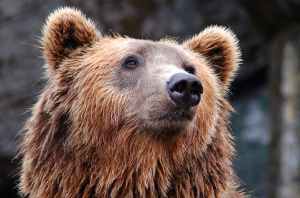
Black Buck
Wednesday, July 18, 2018
Bengal Tiger

Assamese Monkey
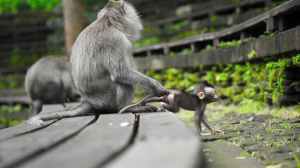
South East Asian Wild Buffalo
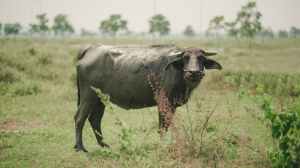
Wednesday, July 11, 2018
Seed Certification

Importance
Storage of seeds

Seed Processing of Forest Trees
[caption id="attachment_114" align="alignnone" width="300"]
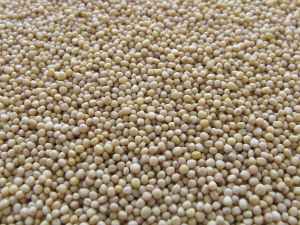 Photo by Pixabay on Pexels.com[/caption]
Photo by Pixabay on Pexels.com[/caption]The objective of Seed Processing is to produce good quality seeds for sowing. The Processes are Pre-cleaning, Pre-curing, Cleaning.
Pre-cleaning involves cleaning of twigs, barks, leaf litter and other impurities before they are sent for extraction. It can be done by hand and by flotation and fruits be separated by blowing and winnowing.
Pre-curing involves the deliberate storage for ripening of seeds and slow air drying of seeds/fruits.
Cleaning of sound seeds from impurities can be done by screening and sieving,sorting,winnowing,flotation. Screening and sieving remove almost all impurities which have different size than the hole in sieve or screen. Sorting according to length may remove longer and shorter impurities. Cleaning by winnowing is a common practice.Likewise, Flotation method can be used to separate out impurities having different specific gravity than that of seed.
Seed Collection of tree species

Bamboo and Rattans
 BAMBOOS are tall, perennial, arborescent grasses, belonging to Poaceae family. There are 50 genera and approximately 1326 species generally inhibiting the humid tropical, sub-tropical and mild temperate regions of the world. It is found in over 18 million hectares of land, of which 75% lies only in Asia.The rhizomes of the Bamboo may be short and thick and clustered together and produce Bamboo in well defined clumps. Mature Bamboo clumps produced new shoots every year throughout the rainy season. The shoots develop then rapidly within 2-3 months and reach their full height and diameter.
BAMBOOS are tall, perennial, arborescent grasses, belonging to Poaceae family. There are 50 genera and approximately 1326 species generally inhibiting the humid tropical, sub-tropical and mild temperate regions of the world. It is found in over 18 million hectares of land, of which 75% lies only in Asia.The rhizomes of the Bamboo may be short and thick and clustered together and produce Bamboo in well defined clumps. Mature Bamboo clumps produced new shoots every year throughout the rainy season. The shoots develop then rapidly within 2-3 months and reach their full height and diameter. RATTANS belong to the family Palmae/Arecaceae. 600 species of Rattans belonging to 13 genera are reported to be distributed worldwide concentrated in Africa and South East Asia.Rattan is an ideal raw material for cottage industries. Its industrial use is in furniture, walking sticks, polo sticks, umbrella handles, basket making, mats, ropes, and various other articles.
RATTANS belong to the family Palmae/Arecaceae. 600 species of Rattans belonging to 13 genera are reported to be distributed worldwide concentrated in Africa and South East Asia.Rattan is an ideal raw material for cottage industries. Its industrial use is in furniture, walking sticks, polo sticks, umbrella handles, basket making, mats, ropes, and various other articles.Sunday, July 8, 2018
Silviculture of indigeneous tree species in Nepal
Sal ( Shorea robusta)
Silvicultural characteristics
Strong light demander, Good coppicer , Seedling die back due to frost, drought, fire , and dense overstorey, Annual seeders but good seed years after every 2 years, Light winged seeds and seeds dispersed by winds.
Silvicultural Systems
Selection system, Irregular shelterwood system, Uniform shelterwood system, One cut shelterwood system, Clearfelling system, Coppice with standards, Coppice with reserves, Simple coppice.
Khair (Acacia catechu)
Silvicultural characteristics
Strong light demander, Seedlings are susceptible to severe frost, Drought resistant, Coppices well unless it is under shade of other species, Seeds produce in abundance, Seeds dispersed by wind and water, requires protection from grazing and browsing.
Silvicultural systems
Clearfelling and Plantation, Simple coppice, coppice with standards, Seed tree method.
Sissoo ( Dalbergia sissoo)
Silvicultural characteristics
Strong light demander, Good coppicer, Annual seeder and seeds produced abundantly, Seeds dispersed by wind and water, Older seedlings can tolerate mild frost, Should be protected against grazing and browsing.
Silvicultural systems
Seed tree method, Clearfelling and plantation by Taungiya, Two storyed high forest system, Simple coppice, Coppice with standards, Coppice with two rotation system.
Chilaune ( Schima wallichi)
Silvicultural characteristics
Not frost hardy,Coppices very well, Good seed year are frequent , Winged light seeds dispersed by wind, Moderately shade tolerant but later it benefits from full overhead light, Capable of colonizing plantations of other species.
Silvicultural systems
Simple coppice, coppice with two rotation, Coppice with standards, Selection coppice, Selection system.
Katus (Castanopsis indica )
Silvicultural characteristics
Moderately shade tolerant, Frost hardy, Benefits from overhead light in later stage, Young seedlings are frost tender, Coppices well.
Silvicultural systems
Simple coppice, Coppice with two rotation, Coppice with standard, Selection coppice, Selection system.
Deodar( Cedrus deodara)
Silvicultural characteristics
Shade bearer and young seedlings benefit from side shade, Winged Seeds dispersed by wind, Young seedlings don't suffer from frost, Very sensitive to fire, Good seed years after every 3 years, Most of the seeds fall close to the parent tree, Profuse regeneration in favorable sites.
Silvicultural Systems
Single tree selection, Irregular shelterwood system, Uniform shelterwood system (40-50 seed trees/ha).
Saturday, July 7, 2018
Important Fodder Tree Species Of Nepal with their Local and English Names
- Acacia nilotica Local name- BABUL E.N. - INDIAN ROSEWOOD
- Aesandra butyracea Local name-CHIURI E.N. - INDIAN BUTTER TREE
- Artocarpus lakoocha Local name- BADAHAR E.N.- MONKEY JACK
- Bauhinia purpurea Local name- TANKI
- Bauhinia variegata Local name- KOIRALO
- Choerospondias axillaris Local name-LAPSI
- Ficus cunia Local name-KHANYU E.N.- FIG
- Ficus nerifolia Local name-DUDHILO E.N.-FIG
- Garuga pinnnata Local name- DABDABE
- Litsea cubeba Local name- SILTIMUR
- Litsea monopetala Local name- KUTMIRO
- Morus alba Local name- KIMBU E.N.- WHITE MULBERRY
- Myrica esculanta Local name- KAPHAL
- Pyrus pashia Local name- MEL E.N.- WILD PEAR
- Sesbania grandiflora Local name- DHAINCHA
Important Exotic Tree Species of Nepal
- Acacia auriculiformis /Family- Mimosaceae
- Callistemon citrinus/ Family- Myrtaceae (Kalki phool)
- Cassia Siamea/ Family- Caesalpiniaceae ( Iron Wood)
- Casuarina equisetifolia / Family- Casuarinaceae
- Ceiba Pontandra / Family- Bombacaceae (Kapok- White Silk)
- Cinnamomum camphora/ Family- Lauraceae ( Camphor Tree-Kapur)
- Crypotomera japonica/ Family- Coniferae ( Dhupi salla- Cryptomeria)
- Delonix regia/ Family- Caesalpinaceae ( Gulmohar- Gold Mohur)
- Eucalyptus camaldulensis/ Family- Myrtaceae ( Red gum - Masala)
- Grevillea robusta / Family- Proteaceae ( Kangiyo- Silver Oak )
- Jacaranda mimosifolia/ Family- Bignoniaceae
- Leucaena leucocephala / Family- Mimosaceae ( Ipil Ipil )
- Pinus Patula/ Family- Pinaceae ( Patula salla)
- Populus ciliata/ Family- Solisaceae ( Himalayan poplar- Bangikot)
- Populus deltoides / Family- Saliscaceae ( Black poplar- Lahre pipal)
- Prosopis juliflora/ Family- Leguminosae ( Mesquite)
- Saraca indica/ Family- Leguminosae ( Asok)
- Tectona grandis / Family- Verbenaceae ( Teak- Sagawan)
Agencies involved in harvesting and distribution of Forest products in Nepal
- Government
- District Forest Office
- Forest Product Development Board(FPDB)
- Timber Corporation of Nepal (TCN)
- Herbs Production and Processing Company Ltd.
- Forest User Groups (FUGs)
- Private Sectors in auctioning
Environmentally Important Days in Nepal
International Mountain Day- Dec 11
World Animal Welfare Day- Oct 4
World Nature Day- Oct 5
National Conservation Day- Asoj 7
World Wildlife Week- Oct 1-7
World Food Day- Oct 16
International Snow leopard Day- Oct 23
International Vulture Awareness Day- Sep 5
International Red Panda Day- Sep 19
World Park Day- Sep 20
World Rhino Day- Sep 22
Conservation Day- Sep 23
Ozone Layer Conservation Day - Sep 26
World Tourism Day- Sep 27
Elephant Day- Aug 12
Tiger Day- July 29
World Environment Day- Jun 5
World Biodiversity Day- May 22
Forest User Day- Jestha 19
World Heritage Day- April 18
Earth Day- April 22
World Migratory Bird Day- April 11-12
BCN Day- April 24
World Wildlife Day- Mar 3
International Forestry Day - Mar 21
World Water Day - Mar 22
World Wetland Day- Feb 2
World Forestry Day- Feb 21
Medicinal/Aromatic plants restricted for export in crude form in Nepal
Silajit- Rox exudate
Sarpagandha- Rauwofia serpentina
Jatamanshi- Nardostychys grandiflora
Sugandhkokila- Cinnamomum glausescens
Sugandhawal-Valeriana wallichii
Lauth Salla- Taxus baccata
Jhyau- Lichen Spps.
Talis Patra- Abies spectabilis
Monday, July 2, 2018
Manufacturing Process of Cutch and Katha and their Uses
Cutch and Katha are obtained by boiling in water, chips of heartwood of Acacia catechu (khair) as the chief constituent of heartwood are Catechin (katha) and catechu-tannic acid (cutch). The manufacturing process is essentially extraction rather than distillation as the chips are boiled in water and not treated with stream.
The manufacture of Cutch and Katha is done by Country method as well as by Factory method. But the country method is wasteful. In Factory Method, wood is chipped by disintegrators and boiled chipped in copper vessels with hot water under slight pressure. The extract is concentrated in vacuum and cooled in a refrigerator tank for about a week, when Katha crystallizes out. It is separated by filter presses cut into slabs and further sliced into square tablets which are then dried. The yield of Katha by this method is about 4 to 5 % by weight of the wood. To obtain Cutch, the liquor is further concentrated in evaporators to a consistency at which it is solidified on cooling. The Cutch yield is about 10 to 12% by weight of the wood.
Katha is mainly used in Pan but sometimes also used in medicine. Cutch is an important commercial product which is used as dyeing and preservative agent. It is used in dyeing cotton and silk and in calico-printing.
LIST OF PROTECTED SPECIES OF MAMMALS OF NEPAL
2.MANIS PENTADACTYLA- PANGOLIN- सालक
3.CAPROLAGUS HISPIDUS- HISPID HARE- खरायो
4.CANIS LUPUS- HIMALAYAN GREY WOLF- ब्हुवासो
5.URSUS ARCTOS- HIMALAYAN BROWN BEAR- रातो भालु
6.AILURUS FULGENS- RED PANDA- हाब्रे
7.PRIONDON PARDICOLOR- SPOTTED LINGSANG- निर बिरालो
8.FELIS BENGALENSIS- LEOPARD CAT- चरी बाघ
9.FELIS LYNX- LYNX-
10.NEOFELIS NEBULOSA-CLOUDED LEOPARD- ध्वासे चीतुवा
11.PANTHERA TIGRIS- TIGER- पाटे बाघ
12.PANTHERA UNICA-SNOW LEOPARD- हिउ चितुवा
13.ELEPHAS MAXIMUS- ASIATIC ELEPHANT- जंगली हाती
14. RHINOCEROS UNICORNIS-RHINOCEROS- गैडा
15.SUS SALVANIUS- PYGMY HOG- बाम पुड्के बदेल
16.MOSCHUS CHRYSOGASTER- MUSK DEER- कस्तुरी मिर्ग
17.CERVUS DUVAUCELI-SWAMP DEER- बाह्रसिंघे
18.BOS GAURUS-GAUR- गौरी गाई
19.BOS GRUNNENIS- WILD YAK- चौरी
20.BUBALUS ARNEE- WILD BUFFALO- अर्ना
21.OVIS AMMON-GREAT TIBETAN SHEEP-नायन
22. PANTHOLOPS HODGSONI-TIBETAN ANTILOPE- चिरु
23.ANTILOPE CERVICAPRA- BLACK BUCK-कृष्णसार
24. TETRACEROS QUADRICORNIS- FOUR HORNED ANTELOPE- चौका
25.HYAENA HYAENA- STRIPED HYAENA- हुडार
26.PLATANISTA GANGETICA-GANGETIC DOLPHIN-सौस
How to determine the age of tree?
The age of trees is either determined by their general appearance or from existing record. The size and taper in stem, size and shape of the crown, and the color and condition of the bark. But this method requires a great practice and experience and to estimate the age of tree within responsible limits of accuracy.
Some trees shows distinct annual rings on their cross section. So the age of the trees when standing can be determined by pressler’s borer. This instrument is used to take out a narrow cylinder of the about 2cm in length from a standing tree at both ends of the diameter. The number of the rings on the cylinders are counted. Then by ratio proportion method, the number of rings on the whole diameter are estimated.
Age of the trees which do not show annual rings is determined by measuring of trees of various sizes at fixed intervals. The measurement of a particular year are then classified by diameter classes and the average diameter of each diameter class is found. The same procedure is followed at subsequent measurements taken after a fixed interval. The difference between the two averages gives the periodic diameter increment which is then plotted against DBH and a smooth curve drawn. The increment curve is transformed into diameter age curve. From this curve, age of any tree of known DBH can be read.
The age of felled tree can be determined if the stump shows the annual rings. The rings are counted after levelling the stump by a chisel along the diameter on which the rings are to be counted. Then age to stump height is added to determine the age of the tree at the time it was felled.
The age of trees is either determined by their general appearance or from existing record. The size and taper in stem, size and shape of the crown, and the colour and condition of the bark. But this method requires a great practice and experience and to estimate the age of tree within responsible limits of accuracy.
Some trees shows distinct annual rings on their cross section. So the age of the trees when standing can be determined by pressler’s borer. This instrument is used to take out a narrow cylinder of the about 2cm in length from a standing tree at both ends of the diameter. The number of the rings on the cylinders are counted. Then by ratio proportion method, the number of rings on the whole diameter are estimated.
Age of the trees which do not show annual rings is determined by measuring of trees of various sizes at fixed intervals. The measurement of a particular year are then classified by diameter classes and the average diameter of each diameter class is found. The same procedure is followed at subsequent measurements taken after a fixed interval. The difference between the two averages gives the periodic diameter increment which is then plotted against DBH and a smooth curve drawn. The increment curve is transformed into diameter age curve. From this curve, age of any tree of known DBH can be read.
The age of felled tree can be determined if the stump shows the annual rings. The rings are counted after leveling the stump by a chisel along the diameter on which the rings are to be counted. Then age to stump height is added to determine the age of the tree at the time it was felled.
Nepali -English and Scientific Name of Some Medicinal plants in Nepal
2.Chirato- Felworts- Swertia Chirayita
3.Jatamasi- Spikenard- Nardostachys grandiflora
4.Kutki-Neopicrohiza scrophulariflora
5.kurilo- Wild Asparagus- Asparagus racemos
6.Sarpgandha- Serpent Wood- Rauwolfia serpentina
7.Loath Salla- Himalayan Yew- Taxus baccata
8.Sugandhawal -Valeriana spss.
9.Ghiu Kumari- Indian aloe- Aloe Vera
10.Kafal- Myrica esculenta
11. Neem- Azadirachta indica
12.Tejpat- Cinamomum spps.
13.Bel- Aegle marmelos
14.Amala- Phyllanthus emblica
15. Pipala- long pepper- Piper longum
16.Yarshagumba-Cordyceps Sinensis
17. Titepati- Mog wort- Artemisia vulgaris
18. Bojho- Acorus calamus
19.Rudarksha-Ultrasum bead- Elaeaocarpus gantrius
20.Vayakur- Dioscorea deltoidea
21.CHutro- Berbery - Berberis aristata
22.Nagbeli- Lycopodium-Lycopodium clavatum
23.Ritha-Soup nut-Spindus Mukorossi
24.Gurjo-Tinospera sinensis
25.Majitho- Indian maddar- Rubia cordifolia
Sunday, July 1, 2018
Glossary of Silviculture
Afforestation- It may be defined as the establishment of a forest by artificial means on an area from which forest vegetation has always or long been absent.
Advance Growth/Advanced Regeneration/ Advanced Reproduction- The seedlings, saplings and poles of specie of the overwood that establishes naturally in a forest before regeneration felling started.
Broad-leaved Tree- Tree with hardwood and belonging to botanical group Dicotyledons.
Budding- It is the method of vegetative reproduction in which a bud with some portion of the bark of a genetically superior plant is grafted on an inferior plant so that it may produce shoot when the old shoot of the stock is cut off.
Clone- All cuttings and grafts derived from one tree by asexual reproduction are collectively called a clone.
Cover Crop- The subsidiary crop of low plants introduced in a plantation to afford soil cover between or below the main crop.
Conifer- Tree bearing cones and generally needle shaped or scale like leaves, usually evergreen and belonging to the order Coniferales of the botanical group, Gymnospermae.
Coppice- It is the method of vegetative reproduction in which the trees, plants or the seedlings of a species when cut from near the ground level, produce coppice shoots. The coppice shoots are the shoots arising from an adventitious bud at the base of a woody plant that has been cut near the ground or burnt back.
Damping off- The killing of the young seedling by certain fungi that causes the decay of the stem or roots.
Die-back- The progressive dying, usually backwards from the tip, of any portion of the plant. It is caused by the adverse climatic and edaphic factors as well as adverse weed conditions.
Frost Hardy Species- The species which possess power to withstand frost without being damaged are called frost-hardy.
Frost Tender- The species which are killed back by the frost are called Frost-tender species.
Germinative Capacity- It is defined as the percentage, by number of seeds in a given sample that actually germinate irrespective of time.
Germinative Energy- It is defined as the percentage by number of seeds in a given sample that have germinated up to the time when the rate of germination reaches its peak.
Girdling- It may be defined as the cutting through the bark and outer living layers of wood in a continuous incision all- around the bole of the tree.
Lopping- The cutting of a branch of a tree.
Mulch- Plant residues and other materials used as a covering for the soil.
Reforestation- The restocking of a felled or otherwise cleared woodland by artificial means. It is the raising of a forest artificially in an area which had forest vegetation before.
Regeneration- It may be defined as “the renewal of the forest crop by natural or artificial means.”
Seed Dormancy- It is a condition of mature viable seed in which germination is considerably delayed even though external conditions favors germination.
Shelterbelt- It is a wide belt of trees, shrubs, grasses, planted in rows which go right across the land at right angles to the direction of prevailing winds to deflect air current, to reduce wind velocity and to give general protection to cultivated areas against wind erosion and desiccating effect of hot winds.
Weeding- The tending operation done in the seedling stage in nursery or in a forest crop that involves the removal or cutting back of all the weeds.
Thinning- The felling made in an immature stand for the purpose of improving the growth and form of the trees that remain, without permanent breaking of the canopy.
Viability- It is defined as the potential capacity of a seed to germinate.
Forest Types of Nepal
Nepal has diverse climatic and topographical features which results in the contribution of different forest types in Nepal.Adapted from J.k. Jackson, here is the list of different forest types of Nepal.
- Tropical forest (up to 1000m)
i.Shorea robusta Forest – The dominant species is Sal and other associates are Terminalia alata, Anogeissus latifolia, Syzyzium cumini,etc.
ii.Acacia catechu- Dalbergia Sissoo Forest- It is mostly found along streams and rivers in deposited alluvium and often gravelly and will be eventually be succeeded by Sal or other types of forest.
iii. Other Riverain forest- This types of forest is not large and extends far from the stream banks. Jamun is dominant in western Nepal.
iv.Grassland- This type is usually found on poorly drained clays. Grass species such as Saccharam spontaneum, Eulaliopsis bipinata, Phragmites Karka.etc are found.
v.Terminalia- Anogeissus deciduous hill forest- It is confined to dry south facing slopes in the larger river valleys and up to 1200m in Western Nepal.
- Sub-Tropical Forest (1000m-1700m in East and 1000m 2000m in West)
i.Pinus roxburghii forest- It is found in the west of Nepal extensively. In the east, it is found in large river valleys. It is almost pure. In the far west at higher altitude, it may be associated with Olea ferruginea, Pistacia spps, etc. In transitional areas, it may be mixed with Schima wallichi or Shorea robusta.
ii.Schima-castanopsis forest – This Schima- castanopsis forest covers very large areas of the mid-hills, but much of it has been cleared for cultivation and very small passages are left.
iii.Alnus nepalensis forest- Alnus nepalensis is dominant and almost pure and associated in some places with Lyonia ovalifolia.
iv.Riverain forest with Toona and Albezia species- It is confined to narrow strips along streams and is very mixed in composition.
- Temperate Forest (2000m-3100m)
i.Lower temperate forest ( 2000m- 2700m)
a.Quercus leucotricophora and Quercus lanata
b.Quercus floribunda forest
c.Quercus lamellose forest
d.Lower temperate mixed broad leaved forest with abundant lauraceae
e.Pinus wallichiana forest
ii.Upper temperate forest (2700m – 3100m)
a.Quercus semecarpifolia forest
b.Upper temperate mixed broadleaved forest
c.Rhododendron Forest
d.Upper temperate coniferous forest
4. Sub- Alpine forest (3000m-4200m)
i.Abies spectabilis forest
ii.Betula utilis forest
iii.Rhododendron forest
iv.Juniperous indica steppe
v.Caragana steppe
- Alpine forest (up to 4500m)
It has no trees, but shrubby Rhodendrons and Junipers and some other shrubby species are found at lower elevations up to about 4500m.
What is CAI and MAI?
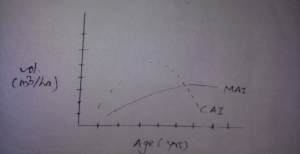
CAI is the increment which a tree puts on in a single year. The CAI varies from year to year being affected by seasonal conditions and treatments.
MAI is the mean volume of a tree or crop put on from origin up to the desired age i.e. the total increment up to a given age divided by that age.
If when the curves of Current and Mean annual increments are plotted over tree age, the two do not coincide with each other through out the life of the tree except at two periods one at the end of first year and the other at the culmination of MAI.The CAI rises to maximum and then gradually fall off.The MAI also increases to a maximum at a later age but with much lower rate.The MAI continues to rise towards maximum even after the CAI has started falling.
When the CAI falls to such an extent it is equal to MAI, the MAI reaches its highest points. This is the year of culmination of the MAI. At later stage, the CAI is less than the MAI, and MAI also beings to drop but not as rapid as that of CAI. THE CAI will be zero and also negative when there is rot or other damages resulting in negative CAI. But the MAI value is never Zero and negative like CAI.
What is DBH ?
- It is a convenient height for taking measurement as it does not require bending down or stretching up to reach a lower or higher point.
- It is a place on a tree stem, which is free from obstructions from thorny shrubs and abnormalities like root swell, etc.
- It gives uniform point of measurement and therefore standardizes measurement.
- It shows strong correlation to the volume or weight of the stem for most tree species.
Rules of the DBH Measurement
- Loose barks, mosses, lichens that are found on the tree must be removed before measuring the diameter over bark.
- Breast Height (BH) should be measured by means of a measuring stick on standing trees at 1.3m or 1.37m (FAO) above the ground level.
- BH should be marked by intersecting vertical and horizontal lines 12 cm long painted with white paint.
- On sloping land, the diameter at BH should be measured on uphill side.
- In case of the tree is leaning, DBH is measured along the tree stem and not vertically, on the side of the lean for trees growing on flat ground and on uphill side, for trees growing on sloping ground.
- BH should be taken at the lowest point above which the buttress formation is not likely to extend.
- When the tree is forked above the BH, it is counted as one tree, but when it is forked below BH, each fork should be treated as though it were a separate tree.
Instruments used in Diameter measurement of trees
The Diameter of a tree cross section may be obtained with a flexible tape by measuring the circumference of the tree. A diameter tape is a measuring tape that has scale on both sides: one side is specially marked to show the diameter of a tree, and the other is a normal scale.
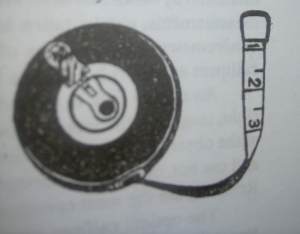
2. Calipers
Calipers are often used to measure tree DBHor when diameters are less than about 60cm. A Caliper may be constructed of metal, plastic or wood, consists of a graduated beam with two perpendicular arms. One arm is fixed at the origin of the scale and the other arm slides.When the beam is pressed against the tree and the arms closed, the beam of the Caliper can be read on the scale.

3. Wooden Scale
It is generally a two feet folding scale used to measure diameters of logs at their end cross sections.

